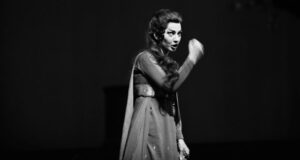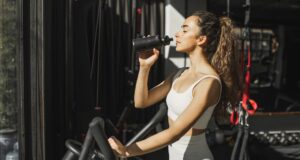
I never considered myself athletic growing up. I did tap, ballet, and acrobatics in elementary school, but I didn’t play any organized sports. As an adult, I got sucked into different exercise fads over the years to manage my weight: Aerobics and running in my late 20s and early 30s, and yoga in my late 40s and early 50s, none of which I stuck with for long. Even though I was fairly active throughout my life, I always struggled with my weight. I was never overweight, but I wasn’t happy with how I looked because the “ideal body type” when I was a pre-teen and teenager was Twiggy’s, which I would never achieve—I’m 5’1 with a more athletic build—but still, I kept trying.
It never really worked, and in my forties, I gained weight due to perimenopause and because I quit smoking. I weighed about 140 pounds, which was a lot for me, and I realized my weight was going to become a problem if I didn’t stay on top of it. So, I started doing strength training sessions with a personal trainer for a few years. Working out had always intimidated me—I never knew what to do or which machines to use—but working with a trainer helped me overcome some of that fear. I gained some muscle, but didn’t lose any weight. Eventually, I stopped because the sessions were expensive.
I was two weeks shy of my 65th birthday when I picked up a barbell for the first time.
I stopped working out for one or two years. But then, in 2016, one of my coworkers told me he was leaving the hospital we worked at in Michigan to go full-time at his boutique gym. He specialized in strength training with barbells for older people, which was intriguing because, at the time, I was about to turn 65. When I looked in the mirror, I realized I was rapidly becoming a little old lady. The little bit of muscle I had looked like it was disappearing overnight due to sarcopenia, which is age-related muscle loss. When I watched people training at his gym one day, I saw a tiny woman who was older than me hoisting heavy barbells—and I knew I wanted to learn how to do that.
So, I started going to his gym twice a week for the next year and a half, and I learned the main compound lifts: squats, deadlifts, bench presses, and overhead presses. But it was hard and scary, especially since I’d taken a couple of years off from working out. I had never pushed myself to do any kind of physical work, and I had to develop confidence to lift heavy weights. Plus, I was fighting the fears our culture instills in us that women are supposed to be small and not muscular, and that I was too old to lift heavy.
Eventually, I moved past my fear of developing muscle because I didn’t want to lose the muscle mass I already had. Still, I was scared that I would hurt myself because I was too old. But I kept lifting heavy barbells, and I got bit by the bug. Finally, I found my sport. When I started lifting heavy, I forgot about my lifelong desire to lose weight because I wanted to be strong instead. Now, I’m stronger than I’ve ever been in my whole life.
My training is focused on my powerlifting competitions.
I left my coworker’s gym after a couple years because the commute was too far, and I’ve been training virtually with Andy Baker, a personal trainer based in Houston, since 2018. I still work out at local gyms, and I’ve made friends with the other lifters, one of whom was involved in the powerlifting community in Michigan and told me about their competitions. I’ve always been a goal-oriented person, and I’m competitive, so I knew I wanted to try powerlifting. I got into the USA Powerlifting federation (USAPL), and my first meet was in 2019. Since then, I’ve competed in 10 meets and have won a world championship in my age division and weight class.
Now, I’m training four days a week in preparation for a big meet on December 14: The USAPL pro series finals. Mondays are my main squat and bench press days, and on Tuesdays, I do deadlift variations, bench press variations, block pulls, and chin ups. Then, on Thursdays, I work on bench press variations again, and Fridays, I do squats, benches, and deadlifts—my favorite exercise.
I mostly do high intensity, low volume training—I lift heavier weights, like squatting 250 pounds or bench pressing 155 pounds for instance, but I do multiple sets of two or three reps. I don’t do any traditional cardio, but after doing a set of five reps of block pulls, I’m flat on the floor out of breath.
On my active rest days, I’ll typically go on a long walk for one or two miles around my block to get some steps in while still allowing my body to recover.
These three things were key to my strength transformation.
1. I logged every training session, including weight, reps, and sets.
This allowed me to look back at my progress and see that I was actually getting stronger, which helped my confidence grow. For instance, I started lifting on April 4, 2016 and squatted with an empty bar weighing 45 pounds. By April 2017, I was squatting 175 pounds. Now, I’m squatting 250+ pounds. The stronger I became in the gym, the more I felt the ripple effects in other aspects of my life, like having more energy.
2. I didn’t let people’s doubts get to me.
So many people in my life—like coworkers and friends—didn’t understand what I was doing and said I was going to hurt myself. In fact, when I first told someone at my gym that I wanted to enter the powerlifting competition, they said, “You’re not going to win.” Well, I showed them. Women my age can—and do—lift heavy. I just had to tune out society’s beliefs that I’m delicate and frail and, instead, listen to my body.
3. I surrounded myself with the right people.
I had so much cultural baggage that I didn’t even know was there, like the stigma that women shouldn’t be strong, and that when you turn a certain age, you can’t learn anything new. But I had people around me who had experience training older people and could see my potential. Now, I’m more comfortable in my body than ever before. I feel liberated that I don’t care about my weight anymore because my focus is on strength. I’m just very curious to see how strong I can get at my age—I’m 73 years old, and I feel like I have way more in me.




